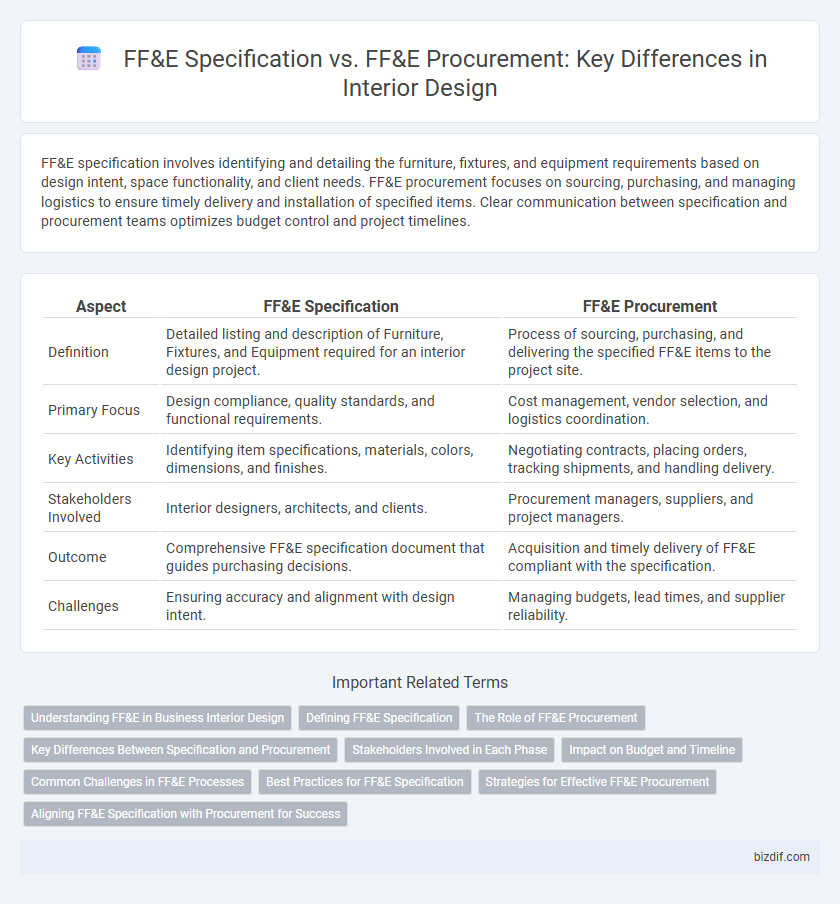FF&E specification involves identifying and detailing the furniture, fixtures, and equipment requirements based on design intent, space functionality, and client needs. FF&E procurement focuses on sourcing, purchasing, and managing logistics to ensure timely delivery and installation of specified items. Clear communication between specification and procurement teams optimizes budget control and project timelines.
Table of Comparison
| Aspect | FF&E Specification | FF&E Procurement |
|---|---|---|
| Definition | Detailed listing and description of Furniture, Fixtures, and Equipment required for an interior design project. | Process of sourcing, purchasing, and delivering the specified FF&E items to the project site. |
| Primary Focus | Design compliance, quality standards, and functional requirements. | Cost management, vendor selection, and logistics coordination. |
| Key Activities | Identifying item specifications, materials, colors, dimensions, and finishes. | Negotiating contracts, placing orders, tracking shipments, and handling delivery. |
| Stakeholders Involved | Interior designers, architects, and clients. | Procurement managers, suppliers, and project managers. |
| Outcome | Comprehensive FF&E specification document that guides purchasing decisions. | Acquisition and timely delivery of FF&E compliant with the specification. |
| Challenges | Ensuring accuracy and alignment with design intent. | Managing budgets, lead times, and supplier reliability. |
Understanding FF&E in Business Interior Design
FF&E specification involves detailed documentation of furniture, fixtures, and equipment requirements tailored to a business interior design project, ensuring alignment with functional and aesthetic goals. FF&E procurement encompasses the sourcing, purchasing, and delivery management of these specified items, focusing on budget adherence and vendor coordination. Understanding the distinction between FF&E specification and procurement is essential for streamlining project timelines and achieving cohesive interior environments in commercial spaces.
Defining FF&E Specification
FF&E Specification involves detailed documentation of furniture, fixtures, and equipment requirements, including design, materials, dimensions, and performance standards to align with the project's aesthetic and functional goals. Precise FF&E specifications ensure that procurement teams source items that match the client's vision and comply with regulatory standards. Defining FF&E Specification is critical for maintaining consistency, quality control, and budget management throughout the interior design process.
The Role of FF&E Procurement
FF&E procurement plays a crucial role in interior design by managing the acquisition of furniture, fixtures, and equipment, ensuring that all items meet project specifications and budgetary constraints. This process involves sourcing suppliers, negotiating contracts, and coordinating delivery schedules to align with construction timelines. Effective FF&E procurement guarantees timely installation and supports the overall design vision while optimizing costs and maintaining quality standards.
Key Differences Between Specification and Procurement
FF&E Specification involves defining detailed requirements and standards for furniture, fixtures, and equipment to ensure design intent and functionality are met. FF&E Procurement focuses on sourcing, purchasing, and managing delivery of specified items within budget and timelines. Key differences include specification emphasizing design accuracy and material quality, while procurement prioritizes cost control and supply chain logistics.
Stakeholders Involved in Each Phase
FF&E specification primarily involves interior designers, architects, and consultants who define the materials, finishes, and products to meet aesthetic and functional requirements. FF&E procurement engages project managers, purchasing agents, and suppliers responsible for sourcing, negotiating, and delivering the specified items within budget and timeline. Collaboration between these stakeholders ensures alignment between design intent and logistical execution for successful project outcomes.
Impact on Budget and Timeline
FF&E specification defines detailed product requirements, including materials, dimensions, and aesthetics, directly influencing accurate budgeting by setting clear cost expectations. FF&E procurement involves sourcing and purchasing specified items, where delays in vendor selection or order fulfillment can extend timelines and cause budget overruns. Effective coordination between specification and procurement minimizes financial risks and ensures project milestones are met within the planned schedule.
Common Challenges in FF&E Processes
FF&E specification involves detailed selection and documentation of furniture, fixtures, and equipment based on design intent, while FF&E procurement focuses on sourcing and purchasing these items within budget and timeline constraints. Common challenges in FF&E processes include managing discrepancies between specified products and available inventory, coordinating lead times with construction schedules, and ensuring compliance with quality standards and regulatory requirements. Effective communication between designers, suppliers, and project managers is critical to mitigate delays, cost overruns, and specification changes during both FF&E specification and procurement stages.
Best Practices for FF&E Specification
FF&E specification involves detailed documentation of furniture, fixtures, and equipment requirements to ensure design intent, functionality, and budget alignment are met precisely. Best practices for FF&E specification emphasize accurate measurement, material selection based on durability and aesthetics, and clear communication with vendors to avoid costly changes during procurement. Implementing standardized templates and collaborating closely with interior designers and project managers enhances efficiency and consistency throughout the project lifecycle.
Strategies for Effective FF&E Procurement
Effective FF&E procurement strategies prioritize detailed FF&E specifications to ensure alignment with project requirements, budget, and timeline. Leveraging vendor relationships and competitive bidding enhances value while maintaining quality and consistency. Implementing a centralized procurement system streamlines order tracking, reduces errors, and optimizes delivery schedules for successful project execution.
Aligning FF&E Specification with Procurement for Success
Aligning FF&E specification with procurement ensures that furniture, fixtures, and equipment choices meet design intent while staying within budget and timeline constraints. Detailed FF&E specifications provide clear criteria for vendors, enabling accurate sourcing and reducing the risk of delays or cost overruns. Coordinated collaboration between design and procurement teams optimizes material quality, delivery schedules, and overall project efficiency.
FF&E Specification vs FF&E Procurement Infographic

 bizdif.com
bizdif.com